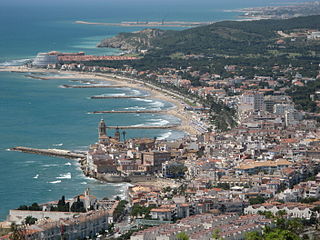
Sitges is a town about 35 kilometres southwest of Barcelona, in Catalonia, Spain, renowned worldwide for its Film Festival, Carnival, and LGBT Culture. Located between the Garraf Massif and the Mediterranean Sea, it is known for its beaches, nightspots, and historical sites.

Tarragona is a province of eastern Spain, in the southern part of the autonomous community of Catalonia. It is bordered by the provinces of Castellón, Teruel, Zaragoza, Lleida and Barcelona and by the Mediterranean Sea.
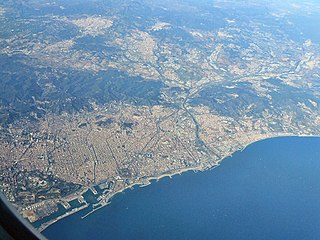
Barcelona is a province of eastern Spain, in the center of the autonomous community of Catalonia. The province is bordered by the provinces of Tarragona, Lleida, and Girona, and by the Mediterranean Sea. Its area is 7,726 km2 (2,983 sq mi). 5,743,402 people live in the province, of whom about 29% (1,664,182) live within the administrative limits of the city of Barcelona, which itself is contained in the Barcelona metropolitan area.
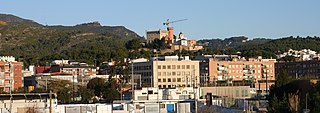
Castelldefels is a municipality in the Baix Llobregat comarca, in the province of Barcelona in Catalonia, Spain, and a suburban town of the Metropolitan Area of Barcelona. Its population is 65,954.

The Costa Daurada is an area on the coast of Catalonia, Spain, between Cunit and Alcanar on the Mediterranean Sea.

Bicaz is a town in Neamț County, Western Moldavia, Romania situated in the eastern Carpathian Mountains near the confluence of the Bicaz and Bistrița Rivers and near Lake Bicaz, an artificial lake formed by the Bicaz Dam on the Bistrița. Bicaz used to be a border town until 1918. Six villages are administered by the town: Capșa, Dodeni, Izvoru Alb, Izvoru Muntelui, Potoci, and Secu.

L'Estartit is a small town and seaside resort on the Costa Brava, on the northeastern coast of Spain, located in the province of Girona, Catalonia.

Vilanova i la Geltrú is the capital city of Garraf comarca, in the province of Barcelona, Catalonia, Spain. Historically a fishing port owned by the Vilanova family, the city has a growing population of approximately 66,000, and is situated 40 km south-west of Barcelona, with the more famous coastal resort of Sitges some 10 km to the north-east.

Eusebi Güell i Bacigalupi, 1st Count of Güell was a Catalan entrepreneur who profited greatly from the industrial revolution in Catalonia in the late 19th century. He married Luisa Isabel Lopez y Bru, daughter of Antonio López y López, 1st Marquis of Comillas and notorious slave trader, in 1871, and the couple had ten children. One of Güell's daughters, Isabel Güell i López, became a noted composer.

C-32 is a primary highway in Catalonia, Spain. It was created in 2004 by merging three sections of existing autopistas and autovías. This re-organisation was part of a renaming of primary highways managed by the Generalitat de Catalunya. According to this new denomination, the first number (C-32) indicates that is a southwest-northeast highway, while the second number (C-32) indicates that is the second-closest to the Mediterranean Sea.

C-31 or Eix Costaner is one of Catalonia's primary highways. It is the result of merging several sections of previously existing roads, autopistas and autovías after the 2004's renaming of primary highways managed by the Generalitat de Catalunya. According to this new denomination, the first number (C-31) indicates that is a southwest-northeast highway, while the second number (C-31) indicates that is the closest to the Mediterranean Sea.
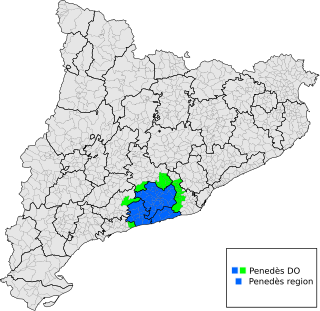
Penedès is a natural and historical region of Catalonia, Spain. It is located in the south of the Principality of Catalonia between the pre-coastal mountain range and the Mediterranean Sea. The comarcal division of the Generalitat de Catalunya in 1936 and 1987, divided Penedès into three administrative comarques: Alt Penedès, Baix Penedès and Garraf, and their capitals are Vilafranca del Penedès, el Vendrell and Vilanova i la Geltrú.
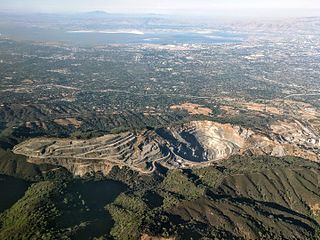
The Permanente Quarry is a limestone quarry in an unincorporated area of Santa Clara County, California, just west of Cupertino, California. The quarry is a limestone and aggregate mining operation and cement plant, owned by Lehigh Southwest Cement, a subsidiary of Heidelberg Cement. Since 1939 the plant has been in operation and is responsible for the production of more than half of the cement used in the Bay Area. Roughly 70 percent of the cement used in the communities of Santa Clara County is acquired from the cement plant.
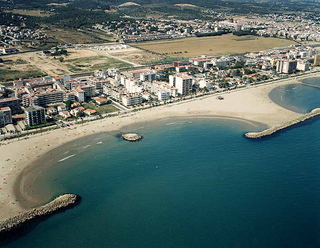
Cunit is a coastal town on the Golden Coast in the Baix Penedès region part of the province of Tarragona in Catalonia, Spain. It is on the northeast coast of Spain on the Mediterranean Sea.

Garraf is a small seaside village located between Sitges and Castelldefels, in the Garraf comarca, Catalonia, Spain, surrounded by the area of the Garraf Natural Park.

Penedès is a Spanish Denominación de Origen Protegida (DOP) for wines in Catalonia, (Spain). Penedès DOP includes all of the Penedès region and municipalities of four other counties: Anoia, Alt Camp, Baix Llobregat and Tarragonès. The area is framed by the coastal hills of the Garraf Massif and the higher inland mountains which skirt the Central Depression.

The Catalan Coastal Range is a system of mountain ranges running parallel to the Mediterranean Sea coast in Catalonia, Spain. It is part of the Catalan Mediterranean System. Its main axis runs between the Foix River and the Roses Gulf and the average altitude is around 500 m. The highest point is 763 m at the Montnegre.

The Garraf Massif is a mountain range of the Catalan Coastal Range, Catalonia, Spain. Its cliffs reach the Mediterranean waters. Its highest point on the coastal side is La Morella, 593 metres above sea level and further inland rises the higher, although less conspicuous, Montau.
The Garraf plot was an attempted regicide of Spain's King Alfonso XIII by Catalan separatists in Barcelona in June 1925.




















